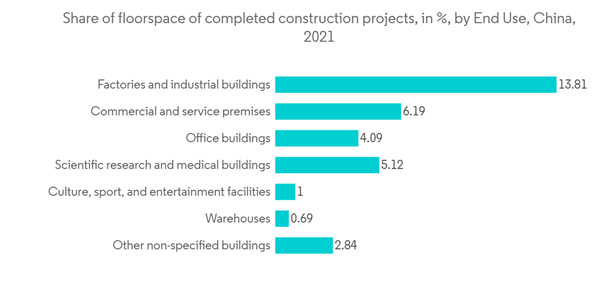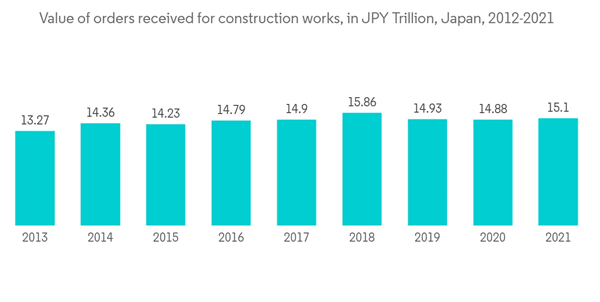Key Highlights
- Bigger buildings require advanced building and predictive analytics, building optimization and continuous optimization, demand response, automated building control, auto, and enterprise integration, while small-sized buildings require a system that can provide information on incentive availability, historical billing analysis, and behavioural, educational, and retrofit suggestions. BEMS plays a crucial role in fulfilling these requirements. Companies are also offering BEMS solutions for medium-sized buildings, in which they are providing energy monitoring, retro and continuous commissioning, NOC availability, maintenance, trouble ticket management, AMI data analysis, and retrofit program suggestions.
- As China's economy expands quickly, the building sector in that country is witnessing an unprecedented boom. This directly affects China's levels of greenhouse gas emissions (GHG) brought on by energy usage in buildings. In October 2021, China's Ministry of Housing and Urban-Rural Development issued national standards for energy conservation and renewable energy use in buildings to enhance the energy efficiency, promote renewable energy, and reduce carbon emissions of buildings. To assist decision-makers in developing building energy performance policy packages that can enhance the energy performance of new and existing buildings in China and restrain the rise of building-related CO2 emissions could boost the growth of the studied market.
- Singapore is also at the forefront of forming favorable government initiatives to support the adoption of smart buildings. Coupled with its Smart Nation initiative, the government introduced the Green Mark Scheme with a target of 80% of buildings to be certified as green under this scheme by 2030. Such initiatives are likely to augment the demand for building energy management systems in the region.
- The Asia Pacific region is also witnessing several innovations catering to efficient energy management for buildings through investments in R&D, collaborations, and mergers. For instance, in October 2022, Tata Power Trading Company announced that it signed an agreement with 75F Smart Innovations India to jointly promote building automation and energy-efficiency solutions in the commercial building space. 75F Smart Innovations is a prominent Internet of Things (IoT)-based building management system firm headquartered in Washington DC. TPTCL, a wholly-owned subsidiary of Tata Power, announced that it would collaborate with 75F Smart Innovations India to offer energy-efficiency solutions across industry verticals, including IT/information technology-enabled services (ITeS), banking financial services and insurance (BFSI), hospitality, health care, education, government, and retail.
- With the growth of technology, smart buildings are growing more and more complex, requiring quicker follow-up looks via retro-commissioning. Adding to that, the risks associated with sustained operational integrity are also mounting. Hence, the demand for comprehensive building energy management systems is expected to spike. It is very important to establish necessary communication between the system providers/designers and owners of the buildings, to understand the functioning of the building. However, market growth is expected to be hindered due to a lack of competent experts skilled in assessing smart solution systems. Professionals operating in the field need to be aware of the design changes and installation in the context of future needs. Failing to do so may lead to complications.
- Moreover, the COVID-19 outbreak has hampered the growth of the building energy management system solution industry due to lockdown measures in the region and delays in the manufacturing and production of BEM products and solutions used in HVAC and non-HVAC applications. The pandemic has also heightened attention on resilience and how society and vital sectors, such as the energy supply, may improve their ability to withstand shocks like the COVID-19 pandemic.
APAC Building Energy Management Systems Market Trends
The Increase in Demand from the Residential Segment is Expected to Drive the Market
- According to China Construction Industry Association, Residential buildings accounted for the largest share of completed construction in China in 2021. Buildings intended for housing accounted for over 67% of the finished floor space. As the country's economy grows, people migrate from rural areas to major cities, increasing demand for residential accommodation in these locations. Furthermore, apartments utilized as investment properties drive up demand. Such a large share of residential buildings would create an opportunity for the market players to develop new products to cater to a wide range of needs of customers.
- Further, according to Housing & Development Board, In the fiscal year 2021/2022, the Housing Development Board in Singapore has 83 thousand residential units under construction. In comparison to the previous year, demand for HDB units had grown.
- Innovative technologies often incentivized through prescriptive utility energy efficiency programs include advanced occupancy and vacancy controls that work with lighting and HVAC systems, daylighting controls, intelligent power strips, smart plugs, and BMS. The Government of India developed 'The Energy Conservation Building Code' (ECBC), which sets minimum energy performance standards for residents and includes the building envelope, heating, ventilation, and air conditioning. Hence, the growing adoption of smart lighting systems could help the country save energy.
- To cater to the evolving needs of consumers, in April 2022, ABB and Samsung Electronics announced that they would collaborate in a global partnership to provide jointly developed technologies for energy management, energy savings, and the smart Internet of Things connection of residential and commercial buildings. As per the companies, buildings generate almost 40% of annual global CO2 emissions. The partnership would create a platform to build a long-term relationship for innovation on smart technology, smart control, and smart devices. The collaboration would enable Samsung and ABB to expand customer access to home automation technologies and better device management while facilitating electricity load shifting.
- Building Energy Efficiency has become a global priority. In Australia, the National Construction Code now includes energy efficiency measures for all building classifications. The National Australian Built Environment Rating System (NABERS) allocates a 0-6 star rating to a building's greenhouse performance and resource efficiency. All Government departments and many businesses are leading the push for more sustainable built environments by no longer taking residency in buildings under 4.5 stars.
Japan is Expected to Witness a High Market Growth
- The rise in the number of construction orders in the region would create several opportunities for the growth of the studied market. For instance, according to MLIT (Japan), the value of orders for building works received by 50 major Japanese constructors in the fiscal year 2021 was around JPY 15.1 trillion (USD 0.11 trillion), marking a 1.5 % increase over fiscal 2020.
- The region also boasts several laws and regulations regarding energy efficiency that are likely to boost the growth of the studied market. For instance, the National Energy Conservation Law includes building energy requirements in Japan. Various provisions of the Energy Conservation Law pertain to the building sector, such as Criteria for Clients on the Rationalization of Energy Use for Buildings and Design and Construction Guidelines on the Rationalization of Energy Use for Houses. The first relates to non-residential buildings, whereas the second applies to residential buildings. Although these rules are designated as voluntary, several components are enforced. For example, building owners must submit a report on energy conservation measures before new construction, extension, alteration, and significant renovations, which must be reviewed and approved.
- Further, in April 2022, the Bill for the Partial Revision of the Law Concerning the Improvement of Energy Consumption Performance of Buildings to Contribute to the Realization of a Decarbonized Society was adopted by Japan's Cabinet. The law accelerates energy-saving building measures to attain carbon neutrality by 2050 and a 46% decrease in greenhouse gas emissions by 2030 compared to 2013 levels. Energy conservation standards, which are currently restricted to non-residential buildings with a floor area of 300 square meters or more, will become mandatory for all new residential and non-residential buildings beginning in 2025.
- Smart cities in Japan are gradually growing across several prefectures, with progressively more companies joining the Smart City Institute Japan, a non-profit organization that connects sectors engaged in developing smart cities in Japan. Smart cities like Kashiwa-no-ha and Fujisawa are encouraging other investors from Japan and the rest of the world to understand the importance of a smarter future. The robust smart city ecosystem in the nation is anticipated to drive the market's growth.
- Moreover, to cater to the complex demands of consumers, several companies in the region are launching new and advanced products & platforms and collaborating with various organizations to extend their geographic reach. For instance, in December 2021, GE Grid Solutions and Fujitsu announced a partnership to sell GE's EnergyAPM asset performance management solutions in Japan. GE's EnergyAPM, which is designed exclusively for grid electrical assets, assists T&D operators and industrials in developing an intelligent performance plan for managing electrical substations and equipment. EnergyAPM's package of software services improves operational reliability while lowering the total cost of ownership by combining asset data with industry expertise, analytics, and connectivity.
APAC Building Energy Management Systems Market Competitor Analysis
The Asia-Pacific Building Energy Management Systems Market is a moderately fragmented market with several significant players like Siemens AG, Honeywell, ABB Ltd., etc. The market players are constantly striving to innovate new products, platforms & services to cater to the complex requirements of their customers. The market players also aim to expand their geographic reach and technical capabilities through collaborations and mergers.- July 2022 - Honeywell launched its new carbon and energy management solution for tracking buildings' emissions. The company's energy-management-as-a-service offering allows companies to account for carbon emissions down to a device level fully. As part of the Honeywell Forge platform for data, analytics, and Internet of Things capabilities, the carbon, and energy management solution is a cloud-based service to aid building owners in optimizing energy usage and carbon emissions (Scope 1 and 2), achieving sustainability throughout the enterprise.
- April 2022 - Schneider Electric, the global player in the digital transformation of energy management and automation and acknowledged as the world's most sustainable corporation in 2021 by Corporate Knights Global 100 Index, launched EcoStruxure Energy Hub, a scalable self-service IoT software as a service solution, which simplifies the management of digitalized electrical and energy systems.
Additional benefits of purchasing the report:
- The market estimate (ME) sheet in Excel format
- 3 months of analyst support
This product will be delivered within 2 business days.
Table of Contents
Companies Mentioned (Partial List)
A selection of companies mentioned in this report includes, but is not limited to:
- Siemens
- Honeywell
- Schneider Electric
- Johnson Controls
- ABB
- Trane
- Building IQ










